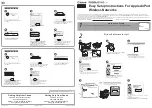
2-9
Cisco Aironet 1520 Series Outdoor Mesh Access Point Hardware Installation Guide
OL-12632-02
Chapter 2 Mounting Instructions
Installation Guidelines
Before Beginning the Installation
Before you begin the installation process:
•
Ensure that a site survey has been performed.
•
Ensure that your network infrastructure devices are operational and properly configured.
•
Ensure that your controllers are connected to switch trunk ports.
•
Ensure that your switch is configured with untagged access ports for connecting your access points.
•
Ensure that a DHCP server with Option 43 configured is reachable by your access points, or
manually configure the controller information in the access point (for additional information, refer
to the
“Configuring DHCP Option 43” section on page F-1
•
Become familiar with the access point installation components (see the
Access Point Installation Components” section on page 2-9
).
Becoming Familiar with Access Point Installation Components
The access point is designed to be installed in an indoor or outdoor environment, such as an interior wall
or ceiling or the exterior roof overhang of a tall building or a streetlight pole. Carefully review the
following figures to become familiar with the system components, connectors, indicators, cables, system
interconnection, and grounding:
•
Components in a typical access point installation (see
)
•
Pole mount installation (see
)
•
Cable strand mount installation (see
)
•
Streetlight power tap installation
(see
Note
The illustrations in this document show all available connections for the access point. Unused
connections are capped with a connector plug to ensure the access point’s watertight integrity. liquid
tight adapters are provided for connector openings, which can be installed before or after deploying the
access point. The illustrations do not show antenna port 5, which is reserved for future use.
















































